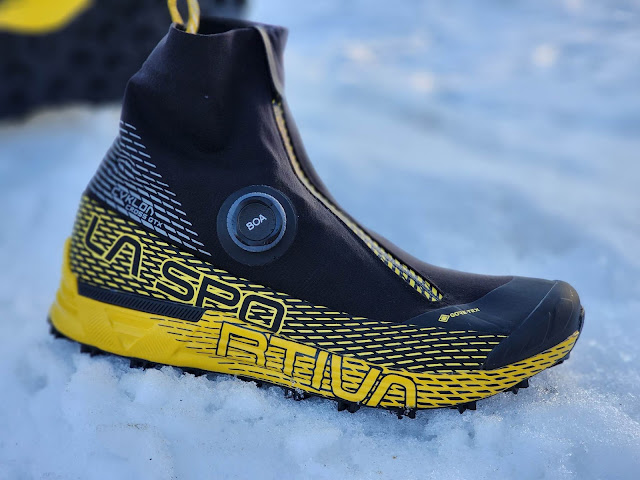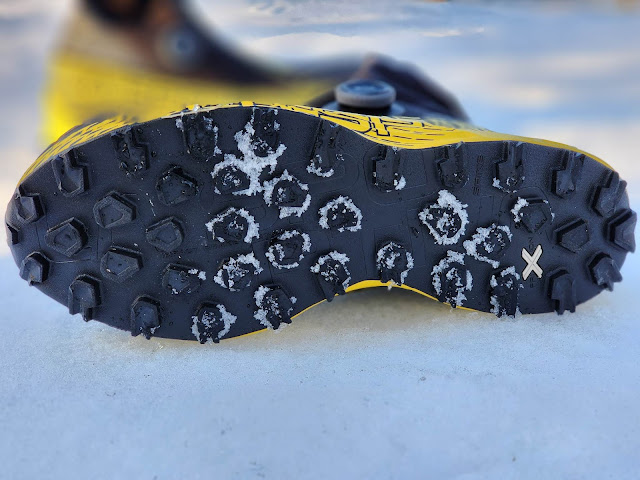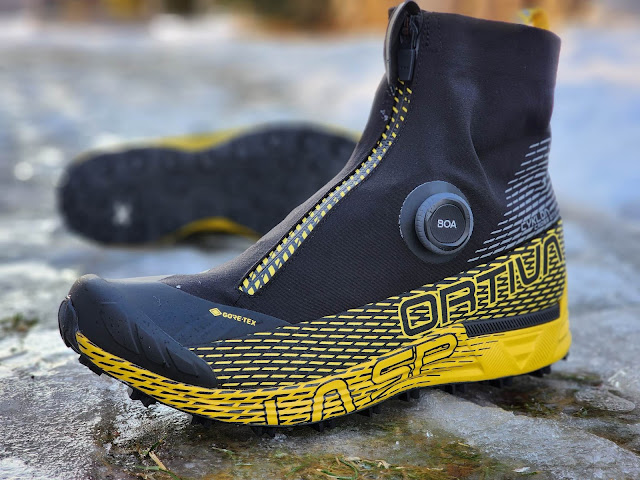La Sportiva Cyklon Cross GTX Review: Conquer the Winter
By Ryan Flugaur
Winter running in Wisconsin can be a challenging time to keep up with the sport. Many of my run club friends choose to leave the dark and cold outside world and head indoors to their warm, climate-controlled gyms with treadmills. I continue to run outside during these extreme conditions, so having the correct equipment is key to staying warm and upright. With new clothing and material advancements I have managed to find a trusty wardrobe to keep warm in almost any temperature but where I often struggle is in my search for footwear. When the roads become snow covered and icy, I typically gravitate from my road running shoes to heavier trail shoes with improved grip and possibly a Gore-tex upper to keep my feet dry. The Cyklon Cross GTX takes it up a notch from my trail shoes and is unlike any other winter running shoe I have tried before.
La Sportiva Cyklon Cross GTXPrice: $245 at La Sportiva
Weight: 12.35 oz, 350 g (men's size 9 - self weighed)
Stack Height: 26.5mm heel, 19.5mm forefoot
Drop: 7mm
Classification: Winter Snow Cross Running
RUNNING SHOE SUMMARY
The La Sportiva Cyklon Cross GTX is a winter running shoe designed with a Gore-Tex upper and a water resistance gaiter to keep your feet dry and warm. Typically, traction is my biggest complaint with many shoes I have tried in the past during the winter months. I was also surprised just how well it performs transitioning from snow covered trails to icy roads thanks to its grippy Frixion 2.0 outsole. The ride is slightly on the firmer side, but this is necessary to prevent the ground from feeling mushy underfoot when trekking through deep and slushy snow. Despite these winter shoe characteristics, does the Cyklon fit the mold for a well-designed winter running shoe? We will dive in to find out.
FIT
The Cyklon Cross GTX is a snug-fitting shoe measuring around a half to a full size smaller than your typical shoe size. When wearing a thin sock, you may be able to get away with a half size larger but if you typically wear thicker socks, especially in the winter, I recommend purchasing a full size larger. The length of the shoe is not the issue as I still have a thumbs width between my big toe and the end of the shoe. The bigger issue is the width, especially in the forefoot. This becomes even more noticeable since the “upper” provides very little stretch leaving the toes feeling cramped. I felt the most pressure over the inside of my big toe but it did not lead to any blisters or pressure spots thanks to the overall well-fitting design. This tightness was not enough for me to stop wearing the shoe however and it will continue to dominate my shoe collection for winter running.
Besides the snugger forefoot issue, I found the fit and comfort to be quite good overall. The BOA lacing system does a great job locking down the foot and I experienced no slippage over the footbed or heel. I also found the turn dial lacing to be very convenient when “lacing up” the shoes with gloves on. Moving to the back of the shoe, there is a semi rigid heel counter that provides good structure to the posterior aspect of the shoe and keeps the heel locked down well. This becomes very important when running in snowy terrain as the shoe tends to stick and a well-fitting shoe is key here. The tongue is integrated into the shoe and supplies an opening for the foot to slide in when the BOA lacing system is on slack. I found this worked very well and the tongue feels very secure over the dorsum of the foot.
Overall, I found the fit secure and comfortable and really enjoyed the convenience of the lacing system. Once you find the right size in respect to the forefoot, the Cyklon Cross GTX offers an extremely comfortable and secure fit overall.
PERFORMANCE
The La Sportiva Cyklon Cross GTX is the 4x4 shoe of off-road running designed for the worst weather conditions. Its water-resistant gaiter helps keep snow and water from affecting your feet while the deep outsole lugs keep your feet underneath you. The BOA lacing system ensures your feet stay planted over the footbed and the GTX inner shoe helps keep the feet warm and dry in those subzero temperatures. My feet had no issues staying warm despite running in 3-4 inches of snow in 10-15°F temperatures. Now given the nature of this shoe, many of my runs were performed in less-than-ideal conditions over snow covered roads, ice, and trails. These conditions determined my pace and many of my miles were run at a slower pace than typical as that was my only safe speed. I was able to use the shoe for some strides following a longer run and it did well, but speed is not the Cyklon Cross strong suit as the high weight (12.35 ounces) and increased forefoot flexibility limits it here.
The midsole is EVA-injected foam and falls on the slightly firmer end. This firmness is beneficial as much this shoe will likely be used over softer snow or mud surfaces and having a firmer ride helps with proprioception and foot placement. This would not be the shoe I chose while running on hard concrete or black top road running surfaces as the lugs and midsole may feel too aggressive. Speaking of lugs, the traction and grip of the Cyklon Cross are unlike any other shoe I have run in. The Frixion XF 2.0 outsole is fantastic over wet and slippery surfaces and does an excellent job biting into the ground even when picking up the pace. I was impressed with the 6.5 mm lugs grip over snowy and icy surfaces but for even icier situations, you do have the option to add AT grip screw in spikes.
Overall, I found the ride to be enjoyable and loved being able to plow through snowy conditions with ease all while keeping my feet dry and warm. Initial contact feels firm and secure thanks to the stabilizer shank (will discuss later) and the forefoot flexibility leads to a nice toe off. The firmer ride is not too hard and feels just about right when running over mushy ground.
STABILITY
From a stability standpoint, the Cyklon Cross GTX offers a neutral ride however due to its unique build it does have some stability properties that make it better suited over uneven terrain. First, the midsole foam used is on the firmer end which helps to keep the foot planted when navigating technical terrain. A soft marshmallow midsole would likely not do well when running over soft and mushy snow as the foot may feel too sloppy. Imagine performing a single leg balance exercise on a piece of foam on top of a bed of random sized marbles. The softer the foam, the more challenging the exercise. Next, the BOA lacing system combined with the gaiter helps hold the foot and ankle in place. This is critical for securing a good lock down when the shoe tends to get stuck while running over snowy surfaces. Lastly, located in the posterior aspect of the shoe there is a TPU shank called the “stabilizer” that gives the shoe anti-torsional stability in the heel and midfoot while allowing forefoot flexibility. This helps to give the heel a stable platform when landing and creates a smooth transition up towards the forefoot. When combining all these characteristics together, it makes for a fairly stable ride when navigating uneven and technical terrain; however, there may be some added requirements of muscular demand as the body responds to these dynamic environments. This will be discussed further in the Thoughts as a DPT section.
Thoughts as a DPT: It Was Definitely the Shoe, Right?
By Ryan Flugar
Waking up the morning following an off road, snow covered 7-mile trail run had me limping when first getting out of bed due to extreme muscle soreness in my feet, calves, hamstrings, and quads. Just pushing off with my foot while walking was sore and uncomfortable in my foot and ankle. So my mind went into problem solving mode. Was this soreness from the new footwear or the fact that I was changing my running terrain?
I had experienced the feeling of being sore early in my running career however being on a running schedule for some time now I seldom experienced muscle soreness to this magnitude. I am aware of changing terrain conditions and its effect on muscular demand but was surprised just how sore I was following this seemingly easy 7-mile jog. Delayed onset muscle soreness (DOMS) is normal and expected following a new activity and something I frequently warn my patients about when teaching a new exercise. This pain is caused by microtrauma tears in the muscle following a new activity and is a normal part of the muscle building process. Limiting how much you do at first and letting the muscle adapt to this new exercise stimulus is key to avoiding too much muscle soreness.
So why was I so sore following one easy jog? When diving into the research, it was found that biomechanics and energy demand change dramatically when transitioning from running on flat to uneven surfaces. For example, when subjects ran on a treadmill with an uneven track the rectus femoris (one of the quadricep muscles) and the medial hamstring muscle activity increased by 20% and 19% respectively compared to running on flat ground. This increase is likely from the body working hard to adjust step length, cadence, and stride to ensure that your foot lands underneath you despite the changing terrain. This same thing happens when running outdoors over snowy packed trails to a possibly even greater degree. Muscles in the feet, legs, and trunk must prepare the body for these dynamically changing surfaces and that places increased work demand on your muscles. This isn't necessarily bad however and I like to think of running on uneven surfaces as a new training method with a different stimulus for the body to adapt to. Other ideas with a similar training response are alternating between trail and road running and performing strides over grassy areas in minimal shoes or barefoot. These training ideas are designed to change up tissue and muscular demand as you build up your muscles in other ways. Doing so will improve tissue loading, neuromuscular control, and muscular demand which will hopefully transition to stronger running and improved muscular strength.
So to answer my question, my soreness was likely a result of many factors. As a runner it is important to consider all changes you make to your running program and the new load it will place on your tendons, muscles, and bones. For example, beginning with hill training, adding 8 miles to your weekly running mileage, and incorporating a brand new shoe all in the same week will increase tissue load and may set you up for an increase in injury. Like we always say at Doctors of Running, questions typically have no easy answer and oftentimes solutions depend on a variety of conditions.
Reference:
Voloshina AS, Ferris DP. Biomechanics and energetics of running on uneven terrain. J Exp Biol. 2015 Mar;218(Pt 5):711-9. doi: 10.1242/jeb.106518. Epub 2015 Jan 23. PMID: 25617451.
RECOMMENDATIONS
The Cyklon Cross GTX is everything that I look for in a winter running shoe. The only modification I would make would be to increase the midfoot width. This would make the shoe even more comfortable when wearing a thicker pair of socks when the weather gets colder. Other than the sizing issue I had I really feel this is a well built and designed shoe and have no further recommendations.
WHO THIS SHOE IS FOR
La Sportiva Cyklon Cross GTX is a winter running shoe designed with warmth, extreme traction, and protection from the elements thanks to its unique gator design and Gore-Tex lining. It performs best on ice and snow covered roads and when the weather is at its worst. Due to the nature of its outsole and ride it performs best for base and easy pace days, but can pick up the pace for short distances. This will be the shoe I reach for during the next few months when I wake up in the morning and the weather scares all other runners indoors.
GRADING
Ryan
Fit: B (Besides the sizing issues, I found the shoe very comfortable with good lockdown)
Performance: A- (My favorite winter running shoe. Best reserved for snow covered roads. May be too aggressive for concrete or clear blacktop roads)
Stability: B+ (Neutral shoe with many stability components that help provide a secure ride over technical terrain)
DPT/Footwear Science: A- (Thoughtful shoe design for winter running)
Personal: A- (My new go to shoe for winter running conditions. I have been searching for a shoe like this for many years.)
Overall: B+/A- (Despite the snugness in the forefoot, this will be a shoe I continue to run in due to its winter versatility and ability to keep my feet warm and dry in the worst weather conditions)
SHOP | SUPPORT DOR
Price: $245 at La Sportiva
Using the following links to purchase helps support Doctors of Running. Thanks so much!
Check out Gear We Love
Ultraspire Fitted Race Belt: The best way to carry your phone and goods on the run. No bounce and various sizes for waist. (Also recommend the Naked belt)
Skratch Recovery, Coffee Flavor: Mental and physical boost post run. Coffee flavor is excellent and goes great straight into a fresh brewed cup
goodr Sunglases: Run in style with goodr's super fun sunglasses.
Feetures Socks: Massively grippy socks that will make you feel more one with the shoe
Amphipod Hydraform Handheld Water Bottle: Perfect for long runs when you need hydration in the summer
Trigger Point Foam Roller: Help get those knots out post-run and feel better for tomorrow
Theragun Massager: This small version is great on the go for working tired legs
Ciele Hat: Our team's favorite running hat of choice!
FURTHER READING: More Weather-Focused Footwear
Saucony Endorphin Shift 3 Runshield
Saucony Endorphin Speed 3 Runshield
Find all Shoe Reviews at Doctors of Running here.
Thanks for reading!
FOLLOW DOCTORS OF RUNNING ON SOCIAL MEDIA
Facebook: Doctors of Running
Youtube Channel: Doctors of Running
Instagram: @doctorsofrunning
LinkedIn: Doctors of Running
Strava: Doctors of Running
Podcast: Virtual Roundtable
Pinterest: Doctors of Running
Editor's Note: As always, the views presented on this website belong to myself or the selected few who contribute to these posts. This website should not and does not serve as a replacement for seeking medical care. If you are currently injured or concerned about an injury, please see your local running physical therapist. If you are in the Los Angeles area, I am currently taking clients for running evaluations.
Contact us at doctorsofrunning@gmail.com
NEXT: ASICS Nimbus 25 Reivew












